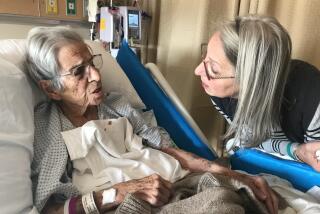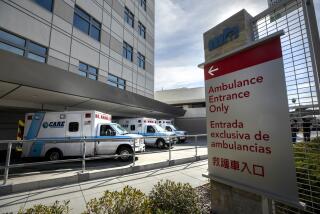Health Care Industry Proves to Be a Magnet for Low-Skill Job-Seekers : New York: Hospitals and nursing homes have replaced factories and the docks as major employers.
- Share via
BROOKLYN, N.Y. — When word got out in late December that Brookdale Hospital was hiring 300 people for its new nursing home, the line formed at 8 a.m.
Welfare mothers, immigrants, out-of-work laborers and jobless high-school graduates from the struggling surrounding neighborhoods of Flatbush and Brownsville gathered outside in the cold. People driving by saw the commotion, parked their cars and joined the line.
By the end of the day, the line of would-be housekeepers, nurse’s aides, cafeteria staff and technicians stretched 4,500 people long.
Forty years ago, these people would have been employed in one of Brooklyn’s thousands of small factories or in the bustling dockyards of Gowanus Bay. But now the factories have moved south, and the docks are dead.
The only industry still hiring in these parts--and in inner-city neighborhoods like them across the country--is health care.
The flip side to soaring health-care costs is that hospitals and nursing homes have become a growth industry in older cities, in many cases the only remaining source of stable, often unionized jobs.
In 1960 health care ranked ninth among New York City’s employers. Today it is first and growing. In just the last 15 years a federal program to provide home health care to the elderly poor has resulted in the creation of nearly 70,000 new jobs in New York, many of them filled by immigrant women entering the work force for the first time.
The critical economic role played by the health-care industry in places like New York City is a wild card in the ongoing debate over health-care reform, a fact that may frustrate any attempt to restructure or curtail spending. That’s because what to the White House and the corporate boardrooms is a system out of control is to the inner city a jobs program--and a good one.
“Whatever one might say about how efficient or fair health-care spending has been, it’s been a godsend for New York City,” said Mathew Drennan, an economist at New York University. “It employs a whole lot of low-income, low-skilled people whose traditional sources of employment have disappeared.”
Today in Manhattan, among the tenements of Washington Heights, the biggest employer is Columbia-Presbyterian Hospital. The biggest employer in Harlem is Harlem Hospital. The biggest employer in the South Bronx is Bronx-Lebanon Hospital. And here in Brooklyn there are 6,800 employees at King’s County Hospital down the road, 4,500 on staff at Brookdale--and no place else even comes close.
In all, during the last three years, the city’s health-care industry hired 30,000 new people, a 12% increase, while the non-health portion of the private sector shrank by 11%.
“We take our cars down to the gas station. We use local contractors when we buy light bulbs. We try to keep our money in the community,” said Brookdale President Frank Maddalena.
Health care’s extraordinary role in poorer communities arises out of an often overlooked facet of modern medicine: that for all of the attention given to the role of high-technology gadgetry and drugs, caring for people’s health remains a business dependent overwhelmingly on cheap labor.
In the automobile industry about 25 cents of every dollar goes directly to wages. In health care the number is closer to 70 cents, most of it going to the paychecks of lower-level support staff.
Private, nonprofit Brookdale, for example, employs 500 doctors and 900 registered nurses. But they are far exceeded by the number of unskilled and semi-skilled jobs at the hospital: 480 nurses’ aides--high-school graduates with a three-month training course--322 technical staff, 1,500 housekeepers, janitors, clerks and general-support staff, and another 743 other assorted skilled and semi-skilled employees.
“The garment workers’ union used to be considered the point of entry into American society,” said Ken Raske, president of the Greater New York Hospital Assn. “People from other countries would come to New York, and that’s where they would get a job. Today it’s health care.”
“An unskilled worker who lands a (unionized) job in an institution in New York starts with $400-a-week salary, a health-care plan with no deductibles, dental-patient care, life insurance, pension fund, child care, mentoring of youth, after-school programs, housing programs, summer-camp programs, scholarship programs and legal programs,” said Dennis Rivera, president of Local 1199 of the National Union of Hospital and Health Care Workers. “You tell me where you can find another (entry-level) job today with all those benefits. They don’t exist.”
Spending money on health care, according to many economists, is not necessarily the best way to create entry-level jobs.
The unanswered question, however, is whether other types of job-growth programs would be as effective in channeling money directly into disadvantaged neighborhoods as health-care spending has been.
More to Read
Sign up for Essential California
The most important California stories and recommendations in your inbox every morning.
You may occasionally receive promotional content from the Los Angeles Times.













